Kutz M. Handbook of materials selection
Подождите немного. Документ загружается.

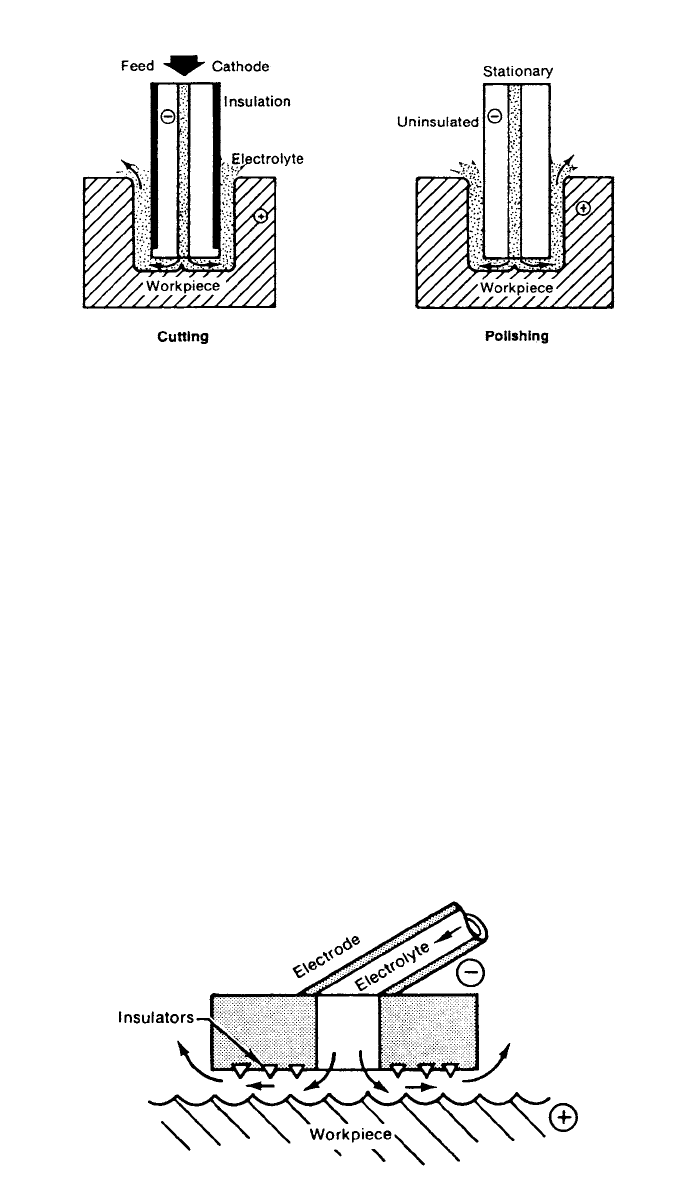
16 NONTRADITIONAL MACHINING 913
Fig. 44 Electrochemical polishing.
Fig. 45 Electrochemical sharpening.
electrodes controls the flow rate. A suction tube picks up the used electrolyte
for recirculation after filtration.
16.17 Electrochemical Turning
Electrochemical turning (ECT) is a special form of electrochemical machining
designed to accommodate rotating workpieces (Fig. 46). The rotation provides
additional accuracy but complicates the equipment with the method of introduc-
ing the high currents to the rotating part. Electrolyte control may also be com-
plicated because rotating seals are needed to direct the flow properly. Otherwise,
the parameters and considerations of electrochemical machining apply equally
to the turning mode.
16.18 Electro-Stream
Electro-stream (ES) is a special version of electrochemical machining adapted
for drilling very small holes using high voltages and acid electrolytes (see Fig.
47). The voltages are more than 10 times those employed in ECM or STEM, so
special provisions for containment and protection are required. The tool is a
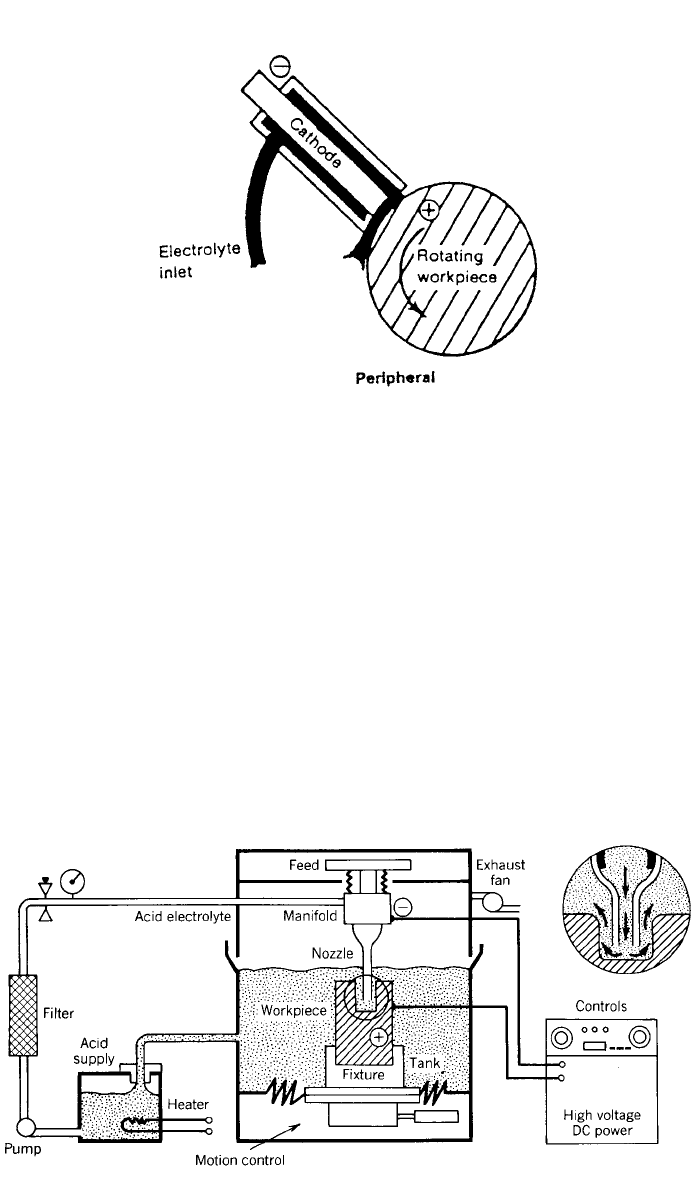
914 PRODUCTION PROCESSES AND EQUIPMENT FOR METALS
Fig. 46 Electrochemical turning.
Fig. 47 Electro-stream.
drawn-glass nozzle, 0.001–0.002 in. smaller than the desired hole size. An elec-
trode inside the nozzle or the manifold ensures electrical contact with the acid.
Multiple-hole drilling is achieved successfully by ES.
16.19 Shaped-Tube Electrolytic Machining
Shaped-tube electrolytic machining (STEM娃) is a specialized ECM technique
for ‘‘drilling’’ small, deep holes by using acid electrolytes (Fig. 48). Acid is used
so that the dissolved metal will go into the solution rather than form a sludge,
as is the case with the salt-type electrolytes of ECM. The electrode is a carefully
straightened acid-resistant metal tube. The tube is coated with a film of enamel-
type insulation. The acid is pressure-fed through the tube and returns via a
narrow gap between the tube insulation and the hole wall. The electrode is fed
into the workpiece at a rate exactly equal to the rate at which the workpiece
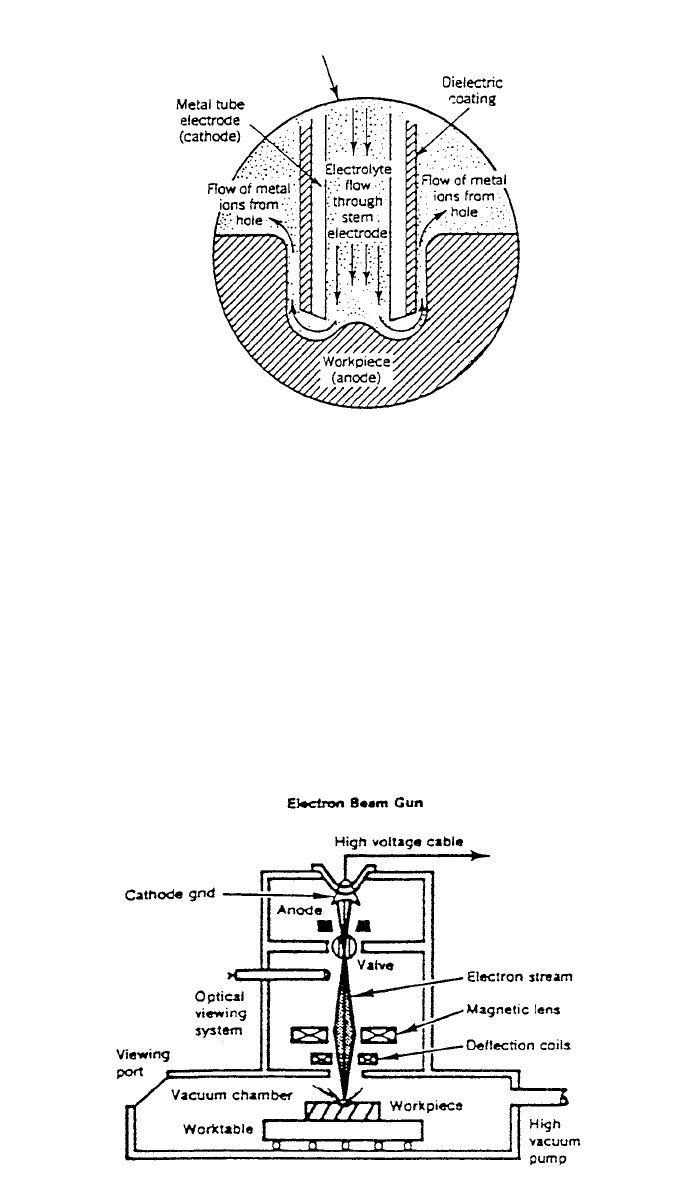
16 NONTRADITIONAL MACHINING 915
Fig. 48 Shaped-tube electrolytic machining.
Fig. 49 Electron-beam machining.
material is dissolved. Multiple electrodes, even of varying diameters or shapes,
may be used simultaneously. A solution of sulfuric acid is frequently used as
the electrolyte when machining nickel alloys. The electrolyte is heated and fil-
tered, and flow monitors control the pressure. Tooling is frequently made of
plastics, ceramics, or titanium alloys to withstand the electrified hot acid.
16.20 Electron-Beam Machining
Electron-beam machining (EBM) removes material by melting and vaporizing
the workpiece at the point of impingement of a focused stream of high-velocity
electrons (Fig. 49). To eliminate scattering of the beam of electrons by contact

916 PRODUCTION PROCESSES AND EQUIPMENT FOR METALS
Fig. 50 Electrical discharge grinding.
with gas molecules, the work is done in a high-vacuum chamber. Electrons
emanate from a triode electron-beam gun and are accelerated to three-fourths
the speed of light at the anode. The collision of the electrons with the workpiece
immediately translates their kinetic energy into thermal energy. The low-inertia
beam can be simply controlled by electromagnetic fields. Magnetic lenses focus
the electron beam on the workpiece, where a 0.001-in. (0.025-mm) diameter
spot can attain an energy density of up to 10
9
W/in.
2
(1.55 ⫻ 10
8
W/cm
2
)to
melt and vaporize any material. The extremely fast response time of the beam
is an excellent companion for three-dimensional computer control of beam de-
flection, beam focus, beam intensity, and workpiece motion.
16.21 Electrical Discharge Grinding
Electrical discharge grinding (EDG) is the removal of a conductive material by
rapid, repetitive spark discharges between a rotating tool and the workpiece,
which are separated by a flowing dielectric fluid (Fig. 50). (EDG is similar to
EDM except that the electrode is in the form of a grinding wheel and the current
is usually lower.) The spark gap is servocontrolled. The insulated wheel and the
worktable are connected to the dc pulse generator. Higher currents produce faster
cutting, rougher finishes, and deeper heat-affected zones in the workpiece.
16.22 Electrical Discharge Machining
Electrical discharge machining (EDM) removes electrically conductive material
by means of rapid, repetitive spark discharges from a pulsating dc power supply
with dielectric flowing between the workpiece and the tool (Fig. 51). The cutting
tool (electrode) is made of electrically conductive material, usually carbon. The
shaped tool is fed into the workpiece under servocontrol. A spark discharge then
breaks down the dielectric fluid. The frequency and energy per spark are set and
controlled with a dc power source. The servocontrol maintains a constant gap
between the tool and the workpiece while advancing the electrode. The dielectric
oil cools and flushes out the vaporized and condensed material while reestablish-
ing insulation in the gap. Material removal rate ranges from 16–245 cm
3
/h.

16 NONTRADITIONAL MACHINING 917
Fig. 51 Electrical discharge machining.
Fig. 52 Electrical discharge sawing.
EDM is suitable for cutting materials regardless of their hardness or toughness.
Round or irregular-shaped holes 0.002 in. (0.05 mm) diameter can be produced
with L/D ratio of 20:1. Narrow slots as small as 0.002–0.010 in. (0.05–0.25
mm) wide are cut by EDM.
16.23 Electrical Discharge Sawing
Electrical discharge sawing (EDS) is a variation of electrical discharge machin-
ing (EDM) that combines the motion of either a band saw or a circular disk saw
with electrical erosion of the workpiece (Fig. 52). The rapid-moving, untoothed,
thin, special steel band or disk is guided into the workpiece by carbide-faced
inserts. A kerf only 0.002–0.005 in. (0.050–0.13 mm) wider than the blade or
disk is formed as they are fed into the workpiece. Water is used as a cooling
quenchant for the tool, swarf, and workpiece. Circular cutting is usually per-
formed under water, thereby reducing noise and fumes. While the work is power-
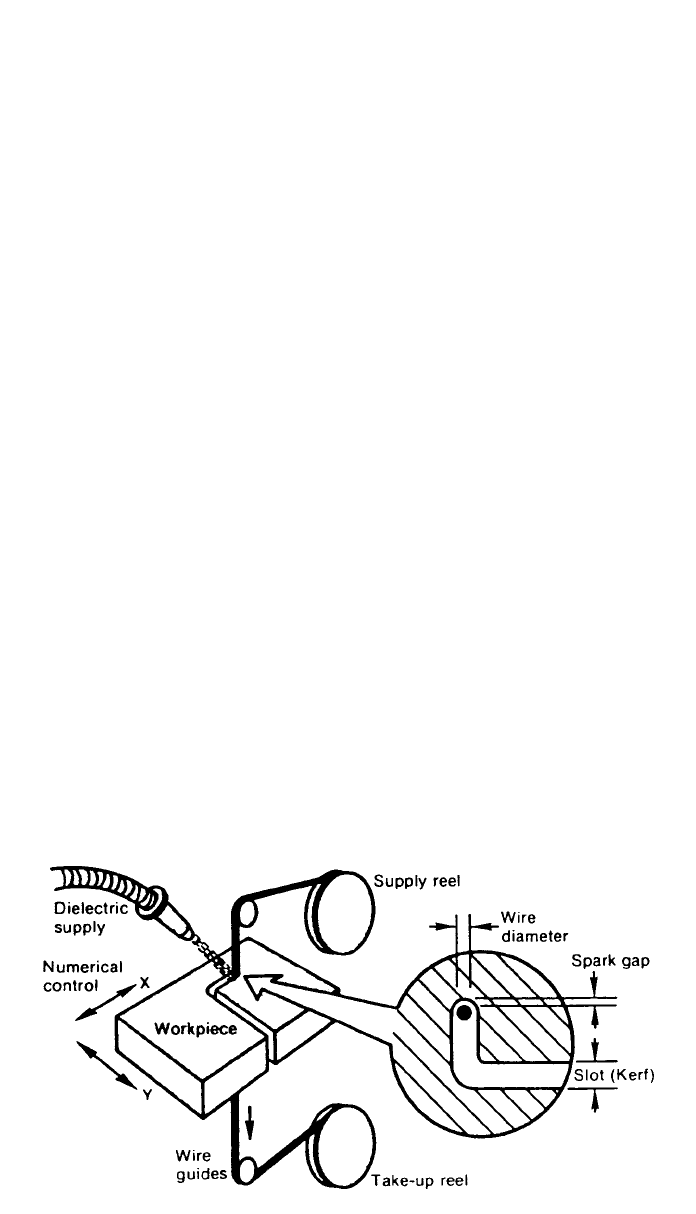
918 PRODUCTION PROCESSES AND EQUIPMENT FOR METALS
Fig. 53 Electrical discharge wire cutting.
fed into the band (or the disk into the work), it is not subjected to appreciable
forces because the arc does the cutting, so fixturing can be minimal.
16.24 Electrical Discharge Wire Cutting (Traveling Wire)
Electrical discharge wire cutting (EDWC) is a special form of electrical dis-
charge machining wherein the electrode is a continuously moving conductive
wire (Fig. 53). EDWC is often called traveling wire EDM. A small-diameter
tension wire, 0.001–0.012 in. (0.03–0.30 mm), is guided to produce a straight,
narrow-kerf size 0.003–0.015 in. (0.075–0.375 mm). Usually, a programmed or
numerically controlled motion guides the cutting, while the width of the kerf is
maintained by the wire size and discharge controls. The dielectric is oil or deion-
ized water carried into the gap by motion of the wire. Wire EDM is able to cut
plates as thick as 12 in. (300 mm) and issued for making dies from hard metals.
The wire travels with speed in the range of 6–300 in./min (0.15–8 mm/min).
A typical cutting rate is 1 in.
2
(645 mm
2
) of cross-sectional area per hour.
16.25 Laser-Beam Machining
Laser-beam machining (LBM) removes material by melting, ablating, and va-
porizing the workpiece at the point of impingement of a highly focused beam
of coherent monochromatic light (Fig. 54). Laser is an acronym for ‘‘light am-
plification by stimulated emission of radiation.’’ The electromagnetic radiation
operates at wavelengths from the visible to the infrared. The principal lasers
used for material removal are the ND:glass (neodymium–glass), the Nd:YAG
(neodymium:yttrium-
aluminum-garnet), the ruby and the carbon dioxide (CO
2
). The last is a gas laser
(most frequently used as a torch with an assisting gas—see LBT, laser-beam
torch), while others are solid-state lasing materials.
For pulsed operation, the power supply produces short, intense bursts of elec-
tricity into the flash lamps, which concentrate their light flux on the lasing ma-
terial. The resulting energy from the excited atoms is released at a characteristic,
constant frequency. The monochromatic light is amplified during successive re-
flections from the mirrors. The thoroughly collimated light exits through the
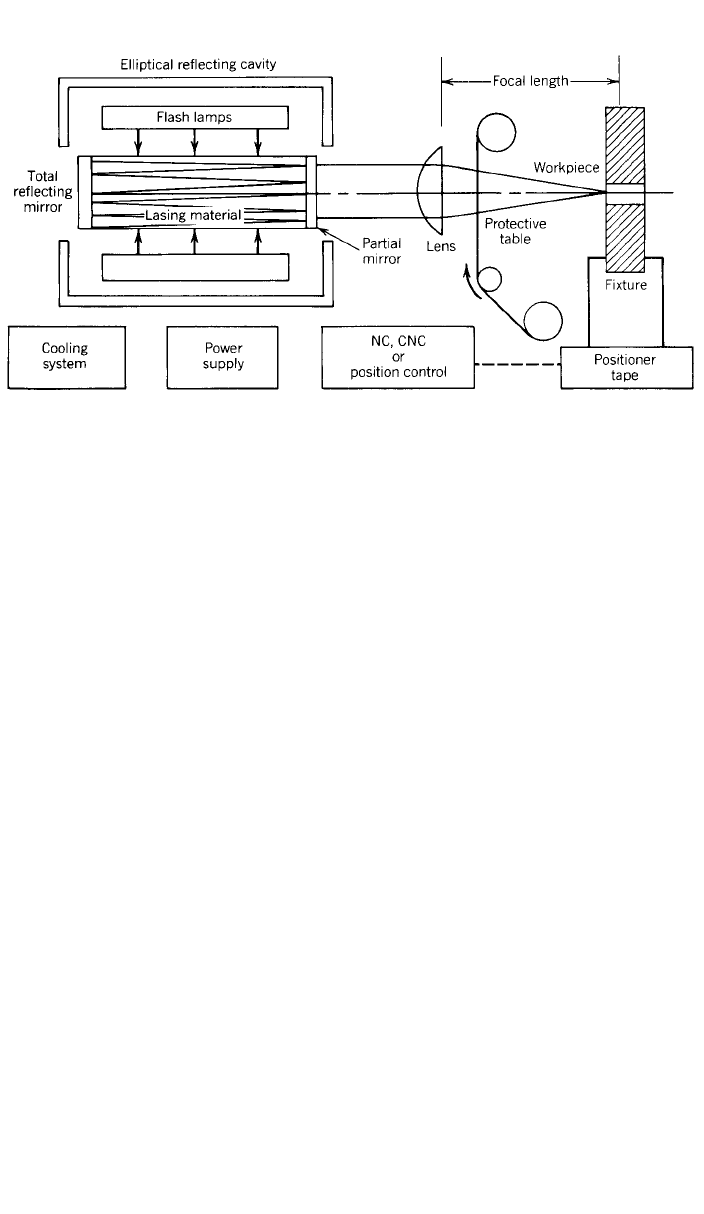
16 NONTRADITIONAL MACHINING 919
Fig. 54 Laser-beam machining.
partially reflecting mirror to the lens, which focuses it on or just below the
surface of the workpiece. The small beam divergence, high peak power, and
single frequency provide excellent, small-diameter spots of light with energy
densities up to 3
⫻ 10
10
W/in.
2
(4.6 ⫻ 10
9
W/cm
2
), which can sublime almost
any material. Cutting requires energy densities of 10
7
–10
9
W/in.
2
(1.55 ⫻
10
6
–1.55 ⫻ 10
8
W/cm
2
), at which rate the thermal capacity of most materials
cannot conduct energy into the body of the workpiece fast enough to prevent
melting and vaporization. Some lasers can instantaneously produce 41,000
⬚C
(74,000
⬚F). Holes of 0.001 in. (0.025 mm), with depth-to-diameter 50 to 1 are
typically produced in various materials by LBM.
16.26 Laser-Beam Torch
Laser-beam torch (LBT) is a process in which material is removed by the si-
multaneous focusing of a laser beam and a gas stream on the workpiece (see
Fig. 55). A continuous-wave (CW) laser or a pulsed laser with more than 100
pulses per second is focused on or slightly below the surface of the workpiece,
and the absorbed energy causes localized melting. An oxygen gas stream pro-
motes an exothermic reaction and purges the molten material from the cut. Argon
or nitrogen gas is sometimes used to purge the molten material while also pro-
tecting the workpiece.
Argon or nitrogen gas is often used when organic or ceramic materials are
being cut. Close control of the spot size and the focus on the workpiece surface
is required for uniform cutting. The type of gas used has only a modest effect
on laser penetrating ability. Typically, short laser pulses with high peak power
are used for cutting and welding. The CO
2
laser is the laser most often used for
cutting. Thin materials are cut at high rates, – in. (3.2–9.5 mm) thickness is
13
––
88
a practical limit.
16.27 Plasma-Beam Machining
Plasma-beam machining (PBM) removes material by using a superheated stream
of electrically ionized gas (Fig. 56). The 20,000–50,000
⬚F (11,000–28,000⬚C)
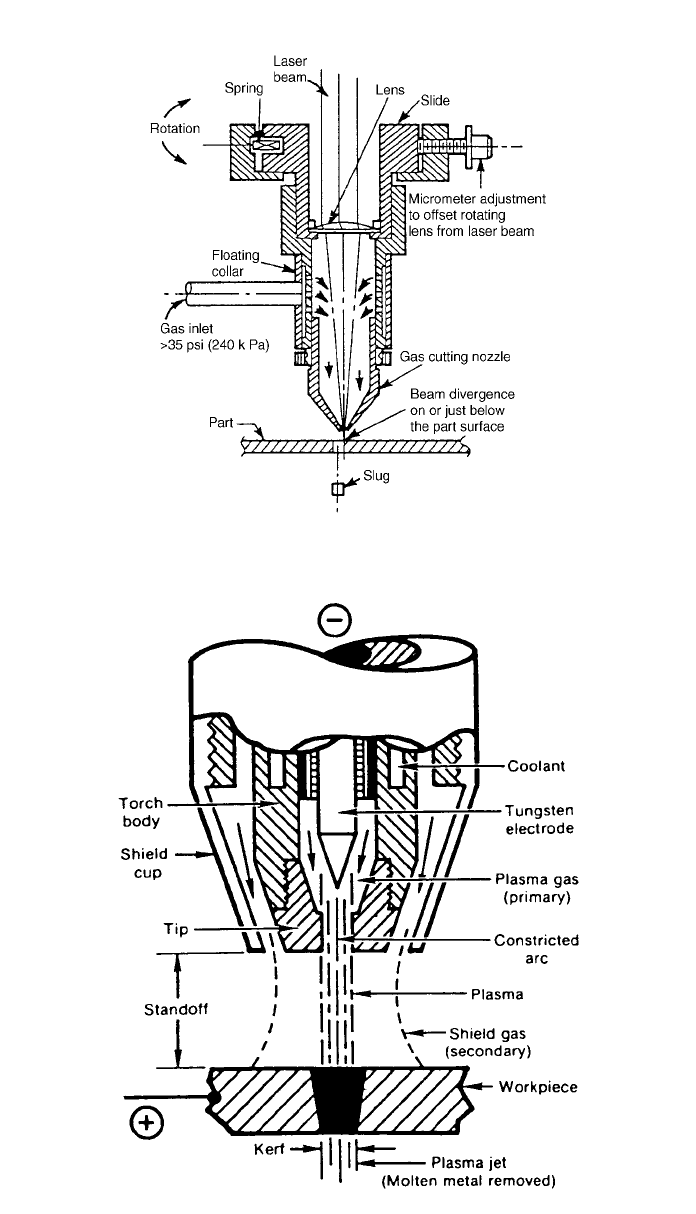
920 PRODUCTION PROCESSES AND EQUIPMENT FOR METALS
Fig. 55 Laser-beam torch.
Fig. 56 Plasma-beam machining.
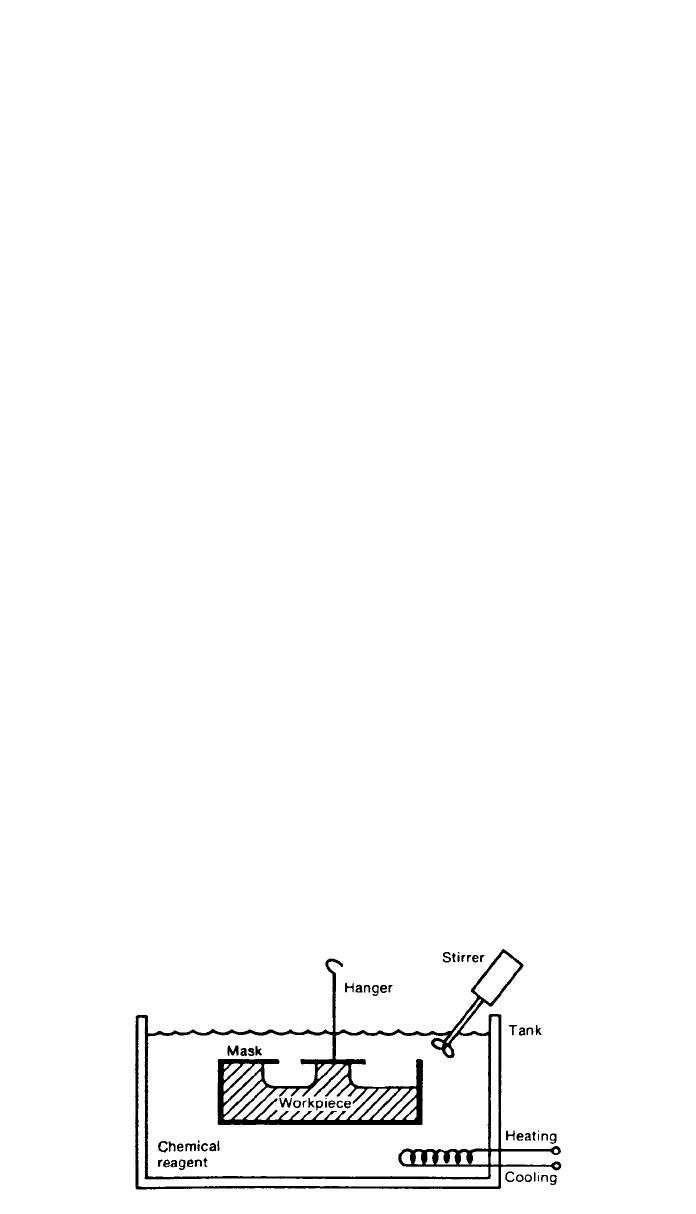
16 NONTRADITIONAL MACHINING 921
Fig. 57 Chemical machining.
plasma is created inside a water-cooled nozzle by electrically ionizing a suitable
gas, such as nitrogen, hydrogen, or argon, or mixtures of these gases. Since the
process does not rely on the heat of combustion between the gas and the work-
piece material, it can be used on almost any conductive metal. Generally, the
arc is transferred to the workpiece, which is made electrically positive. The
plasma—a mixture of free electrons, positively charged ions, and neutral
atoms—is initiated in a confined, gas-filled chamber by a high-frequency spark.
The high-voltage dc power sustains the arc, which exits from the nozzle at near-
sonic velocity. The high-velocity gases blow away the molten metal ‘‘chips.’’
Dual-flow torches use a secondary gas or water shield to assist in blowing the
molten metal out of the kerf, giving a cleaner cut. PBM is sometimes called
plasma-arc cutting (PAC). PBM can cut plates up to 6.0 in. (152 mm) thick.
Kerf width can be as small as 0.06 in. (1.52 mm) in cutting thin plates.
16.28 Chemical Machining: Chemical Milling, Chemical Blanking
Chemical machining (CHM) is the controlled dissolution of a workpiece material
by contact with a strong chemical reagent (Fig. 57). The thoroughly cleaned
workpiece is covered with a strippable, chemically resistant mask. Areas where
chemical action is desired are outlined on the workpiece with the use of a
template and then stripped off the mask. The workpiece is then submerged in
the chemical reagent to remove material simultaneously from all exposed sur-
faces. The solution should be stirred or the workpiece should be agitated for
more effective and more uniform action. Increasing the temperatures will also
expedite the action. The machined workpiece is then washed and rinsed, and the
remaining mask is removed. Multiple parts can be maintained simultaneously in
the same tank. A wide variety of metals can be chemically machined; however,
the practical limitations for depth of cut are 0.25–0.5 in. (6.0–12.0 mm) and
typical etching rate is 0.001 in./min (0.025 mm/min).
In chemical blanking, the material is removed by chemical dissolution instead
of shearing. The operation is applicable to production of complex shapes in thin
sheets of metal.
16.29 Electropolishing
Electropolishing (ELP) is a specialized form of chemical machining that uses
an electrical deplating action to enhance the chemical action (Fig. 58). The
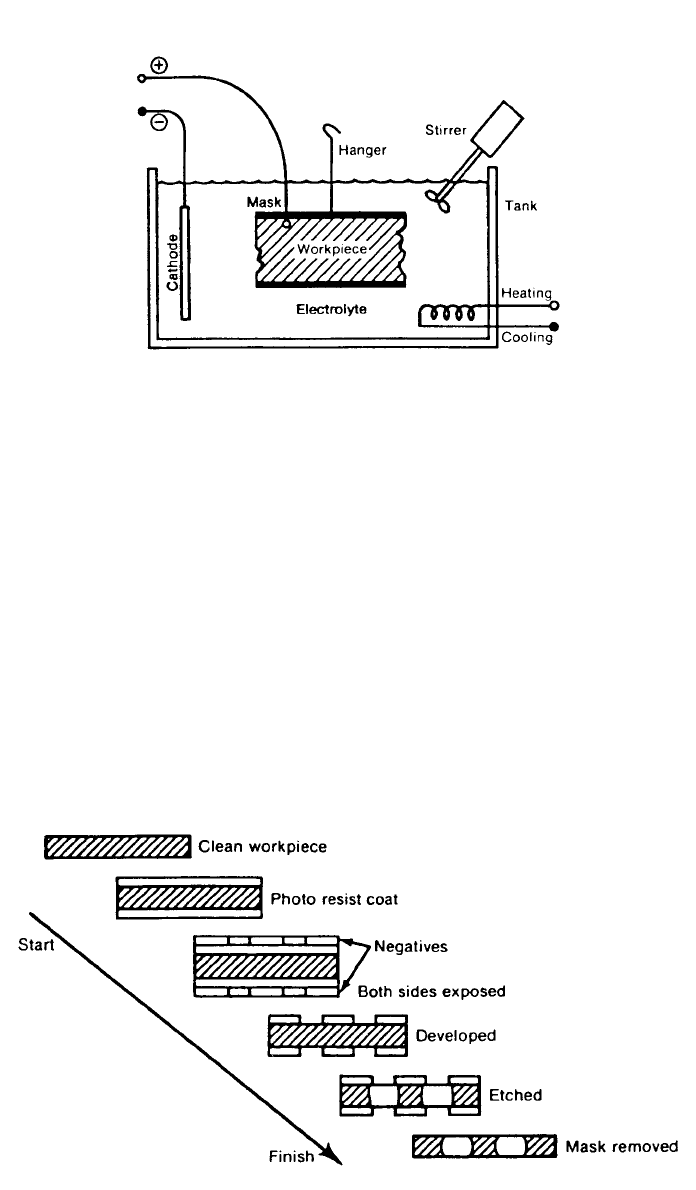
922 PRODUCTION PROCESSES AND EQUIPMENT FOR METALS
Fig. 58 Electropolishing.
Fig. 59 Photochemical machining.
chemical action from the concentrated heavy acids does most of the work, while
the electrical action smooths or polishes the irregularities. A metal cathode is
connected to a low-voltage, low-amperage dc power source and is installed in
the chemical bath near the workpiece. Usually, the cathode is not shaped or
conformed to the surface being polished. The cutting action takes place over the
entire exposed surface; therefore, a good flow of heated, fresh chemicals is
needed in the cutting area to secure uniform finishes. The cutting action will
concentrate first on burrs, fins, and sharp corners. Masking, similar to that used
with CHM, prevents cutting in unwanted areas. Typical roughness values range
from 4–32
in. (0.1–0.8
m).
16.30 Photochemical Machining
Photochemical machining (PCM) is a variation of CHM where the chemically
resistant mask is applied to the workpiece by a photographic technique (Fig.
